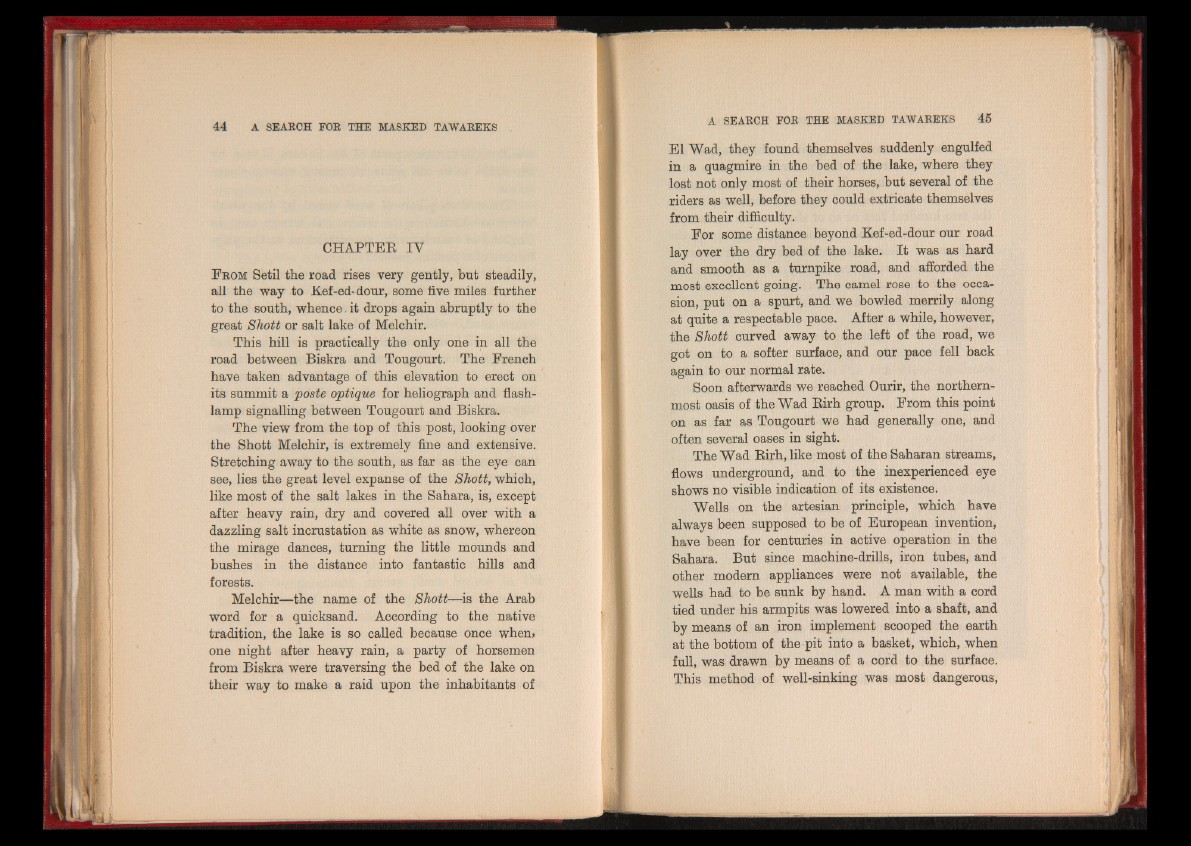
CHAPTER IY
F rom Setil the road rises very gently, but steadily,
all the wa y to Kef-ed-dour, some five miles further
to the south, w h en c e . it drops again abruptly to th e
great Shott or salt lake of Melchir.
This hill is practically the only one in all the
road between Biskra and Tougourt. The French
have taken advantage of this elevation to erect on
its summit a poste optique for heliograph and flash-
lamp signalling between Tougourt and Biskra.
The view from the top of this post, looking over
the Shott Melchir, is extremely fine and extensive.
Stretching away to the south, as far as the eye can
see, lies the great level expanse of the Shott, which,
like most of the salt lakes in the Sahara, is, except
after heavy rain, dry and covered all over with a
dazzling salt incrustation as white as snow, whereon
the mirage dances, turning the little mounds and
bushes in the distance into fantastic hills and
forests.
Melchir—the name of the Shott—is the Arab
word for a quicksand. According to the native
tradition, the lake is so called because once when»
one night after heavy rain, a party of horsemen
from Biskra were traversing the bed of the lake on
their way to make a raid upon the inhabitants of
El Wad, they found themselves suddenly engulfed
in a quagmire in the bed of the lake, where they
lost not only most of their horses, but several of the
riders as well, before they could extricate themselves
from their difficulty.
For some distance beyond Kef-ed-dour our road
lay over the dry bed of the lake. It was as hard
and smooth as a turnpike road, and afforded the
most excellent going. The camel rose to the occasion,
put on a spurt, and we bowled merrily along
at quite a respectable pace. After a while, however,
the Shott curved away to the left of the road, we
got on to a softer surface, and our pace fell back
again to our normal rate.
Soon afterwards we reached Ourir, the northernmost
oasis of the Wad Birh group. From this point
on as far as Tougourt we had generally one, and
often several oases in sight.
The Wad Birh, like most of the Saharan streams,
flows underground, and to the inexperienced eye
shows no visible indication of its existence.
Wells on the artesian principle, which have
always been supposed to be of European invention,
have been for centuries in active operation in the
Sahara. But since machine-drills, iron tubes, and
other modern appliances were not available, the
wells had to be sunk by hand. A man with a cord
tied under his armpits was lowered into a shaft, and
by means of an iron implement scooped the earth
at the bottom of the pit into a basket, which, when
full, was drawn by means of a cord to the surface.
This method of well-sinking was most dangerous,